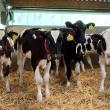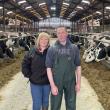We wanted to improve our overall cow health and mobility, so we worked together with Advanced Nutrition. Their Advanced Mobility program helped to give us a true understanding of the lameness and mobility issues we had within the herd.
Benefits from sampling grass
Sampling grass a week ahead of scheduled cutting will pay dividends for dairy farmers focused on producing a clamp of high quality silage this coming season, suggests Advanced Nutrition’s Mark Gorst.

Plan a head is the advice from Advanced Nutrition's Mark Gorst. "Determine if the grass is on target for harvest by taking a sample of grass from the field to be cut and send for analysis with a 48 hour turn around," he advises. "It’s another tool in the box which can be used to potentially make significant feed cost savings particularly when trial findings reveal a staggering variation in silage energy content year on year."
Two year grass trial
The two year trials carried out at by Advanced Nutrition & DLF on David and Chris Halhead’s dairy unit at Bay Horse, Lancaster. It looked at the opportunities of using a grass mixture containing DLF’s Advanced grasses ideally suited to intensive silage production for their 160-cow herd averaging 10,000 litres. The mix included varieties bred to provide excellent forage quality combined with good persistence, stress tolerance and disease resistance, and included some designed to provide enhanced fibre digestibility (DNDF).
Sampling techniques
In 2014 first and second cuts were manually weighed, by cutting a 0.5m2 area to calculate yield, and analysed for dry matter (DM), metabolisable energy (ME), neutral detergent fibre (NDF) and nitrogen content to ensure the sward was ready for cutting. The same sampling process was repeated on exactly the same days 12 months later, the only difference being the weather. The results show a difference of 3,540MJ less clamped in 2014. See table.
Chris Halhead comments: “Whilst using a grass mixture suited to the farming system is key to maximising milk production, the differences in energy yield have demonstrated that cutting at the right time, if conditions and contractors allow, will also save money over the feeding period.”
Mark Gorst continues: “Considering grass silage is costed at £0.93 per MJ/ME DM(Nix 2016), then the cost of replacing 3,540MJ in the diet with brewers grains at £1.96 per MJ/ ME DM (Nix 2016) would be £36.46. For a 1,000t clamp at 28% DM then those losses would amount to a significant £2,953.”

“Consequently, to maximise your forage potential cutting at the right time is crucial.
While it may appear that the quantity is a lot less than letting the crop ‘bulk up’, the quality will pay. Savings made by cutting at the correct time will assist in paying for the extra cut required to make up the quantity.”
Appreciate grass quality DLF’s John Read comments: “The trial outcome led us to beg the question, is there sufficient appreciation of grass quality leading up to ensiling? It’s a case of farmers responding by being aware of the season and taking action - sample grass.
If the sample analysis indicates that the grass is at the required energy and nitrate levels, then don’t wait to cut. D value falls by 0.5 unit (0.08 MJ) a day from when the grass starts to head."
Saving purchased feed
Mark Gorst adds: “Fine tuning and pursuing quality forage rather than sacrificing it for yield should be the way forward. Admittedly, there are limiting factors to cutting at the right time not least the weather and contractor availability.
"However, poor forage with low DM and low energy yield will need substituting with bought in feed, which will in almost every case cost more per unit of energy than from forage.”
The 3 M rule
Adopt the following 3 M rule when trying to decide if your grass ready for cutting.
Monitor
- Calculate an approximate cutting date from the fertiliser, organic and inorganic that has been applied
- Take into account the heading dates of the mixtures that have been sown
- Take into account the weather conditions
Measure
- Sample across the fields to be cut approximately five days ahead of scheduled cutting date
- Remember younger swards will react differently to the more mature sward.
- If the results show the grass is ready for cutting
Mow
- Take the opportunity to cut, but only if the grass is ready, in order to optimise its potential
〈 BACK




